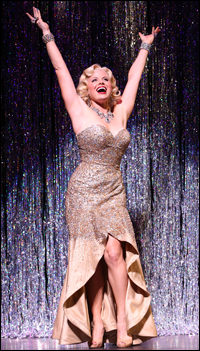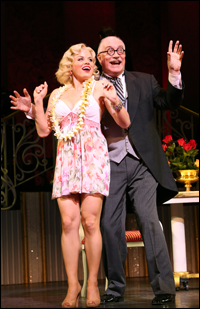
*
One of the joys of bringing to life the delightful score of Gentlemen Prefer Blondes, music by Jule Styne and lyrics by Leo Robin, is getting to hear the imaginative vocal arrangements of the incomparable Hugh Martin. Martin, who passed away just last year at the age of 96, had a long and eventful career as a composer and an arranger both on Broadway and in Hollywood. In the 1930s and 1940s he changed the sound of Broadway shows by introducing the tight jazz harmonies that were being used by popular vocal groups heard on the radio. In doing so, he energized the theatre and helped lead musicals forward into a new era.
Hugh Martin is probably best remembered for composing some timeless songs for the 1944 M-G-M musical, "Meet Me In St. Louis." "The Trolley Song," "The Boy Next Door" and "Have Yourself a Merry Little Christmas" brought him much acclaim and also helped forge his long friendship and musical partnership with Judy Garland. Martin, with various collaborators including Ralph Blane, also composed five Broadway musicals, including Best Foot Forward (1941), High Spirits (1964), and the stage adaptation of Meet Me In St. Louis (1989).
As a vocal arranger, he worked on more than 20 Broadway shows, arranging the music of Richard Rodgers, Vernon Duke, Harold Arlen, Cole Porter, and others, including Jule Styne, who provided the tuneful score for Gentlemen Prefer Blondes.
 |
||
| Megan Hilty in the Encores! Gentlemen Prefer Blondes. |
||
| photo by Joan Marcus |
"It is precisely because your songs are so great that I dare to ask this question: why do I never hear anything resembling a vocal arrangement when I go to see a Broadway musical? … When I go to the movies, I hear all sorts of inventive treatments that seen to me to enhance the quality of the songs …. I find that I enjoy the surprises that musical movies give me when they elaborate on the simple verse and two chorus routines…"
This was a pretty gutsy letter for a 24-year-old to write to one of the masters of Broadway. But it shows that Martin was interested in bringing the modern sound of Hollywood and what he was hearing on the radio to the stages of Broadway. In the 1930s, the sound of Broadway was still largely rooted in the European operetta tradition, and even the lighter scores of Rodgers and Hart or Cole Porter often employed utilitarian and straightforward choral arrange¬ments. There weren't a lot of musical "surprises", as Martin said in his letter.
 |
||
| Megan Hilty and Simon Jones in Gentlemen Prefer Blondes. |
||
| Photo by Joan Marcus |
On top of that basic harmonic approach, Martin employed rhythmic variations, syncopations, tempo shifts and even the use of nonsense syllables to further decorate the tunes. Unison lines unexpectedly explode into blasts of harmony. The keys he chose put the voices in exciting ranges. Broadway hadn't heard anything like this before he came along. In an era long before microphones, this new style required singers of superior musicianship, accurate in pitch and rhythm, and possessing great vocal control.
In Gentlemen Prefer Blondes, listen to the lively syncopations and exuberant rhythms in "High Time" followed by the lush blend of the singers in "Bye, Bye, Baby". Martin has great fun with the French language in the Paris scene and the song "Sunshine", and he uses some unexpected group scat singing in "Keepin' Cool with Coolidge."
Gentlemen Prefer Blondes provides a look at late-1940s nostalgia of life in the 1920s, but Hugh Martin's fresh and innovative vocals pull the sound of the show into the 1950s. Martin always wanted to be modern, and in striving to put the sounds of popular music on the Broadway stage he recognized that a Broadway chorus could enhance the tune by being jazzy and theatrical. In doing so, he played an important part in the evolution of the Broadway musical, and it's "high time" we celebrate him for doing so.
(Rob Berman is music director of Encores! This piece appears in the Playbill of the May 9-13 Encores! concert of Gentlemen Prefer Blondes.)










